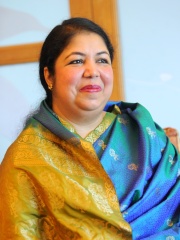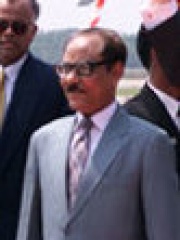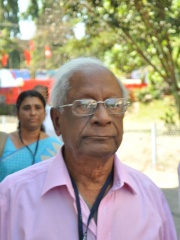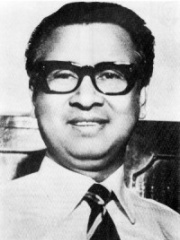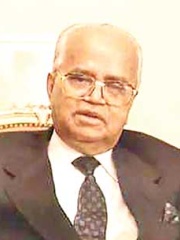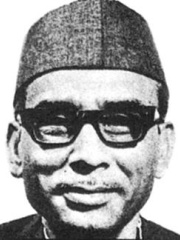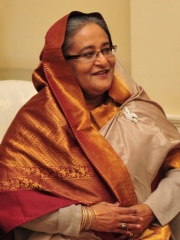
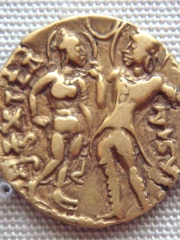
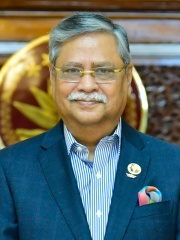
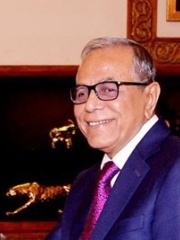
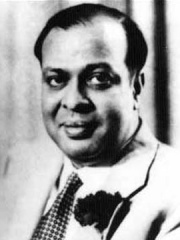
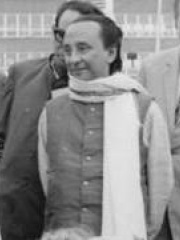
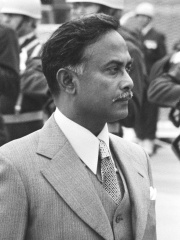
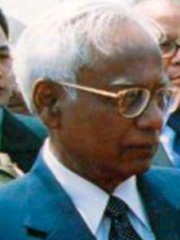
The Most Famous
POLITICIANS from Bangladesh
This page contains a list of the greatest Bangladeshi Politicians. The pantheon dataset contains 19,576 Politicians, 26 of which were born in Bangladesh. This makes Bangladesh the birth place of the 98th most number of Politicians behind Kyrgyzstan, and Taiwan.
Top 10
The following people are considered by Pantheon to be the top 10 most legendary Bangladeshi Politicians of all time. This list of famous Bangladeshi Politicians is sorted by HPI (Historical Popularity Index), a metric that aggregates information on a biography's online popularity. Visit the rankings page to view the entire list of Bangladeshi Politicians.

1. Sheikh Hasina (b. 1947)
With an HPI of 79.96, Sheikh Hasina is the most famous Bangladeshi Politician. Her biography has been translated into 101 different languages on wikipedia.
Sheikh Hasina Wazed (born 28 September 1947) is a Bangladeshi politician who served as Prime Minister of Bangladesh from 1996 to 2001 and again from 2009 to 2024. She is the daughter of Sheikh Mujibur Rahman, Bangladesh's founding president, and has been President of the Awami League since 1981. During her tenure, she became the country's longest-serving prime minister and one of the longest-serving female heads of government globally. Born to the Tungipara Sheikh family in Gopalganj, Hasina had little presence in politics prior to the assassination of Sheikh Mujibur Rahman in 1975. After years in exile, she returned to Bangladesh in 1981 and became President of the Awami League. She led the party in opposition to military rule and played a key role in the 1990 uprising that restored parliamentary democracy. After serving as Leader of the Opposition from 1991 to 1996, she won the June 1996 general election, beginning her first term as prime minister. She served as Leader of the Opposition again from 2001 to 2006 before winning the 2008 general election and beginning her second premiership. Her second premiership was marked by significant economic and infrastructural development, as well as increasing international concern over democratic backsliding, enforced disappearances, human rights abuses and restrictions on political opposition and press freedom. Critics accused her government of consolidating power, corruption and embezzlement of foreign reserve. Observers raised allegations of electoral irregularities in the 2014, 2018 and 2024 general elections. In July 2024, mass student-led protests began, which security forces cracked down on, resulting in the deaths of hundreds of protesters. The protests culminated in her resignation and flight to India in August 2024. In November 2025, she was convicted in absentia by the Bangladeshi International Crimes Tribunal on charges of crimes against humanity, including ordering lethal force against protesters, and sentenced to death, which she rejected as politically motivated. Hasina was among Time magazine's 100 most influential people in the world in 2018, and was listed as being one of the 100 most powerful women in the world by Forbes in 2015, 2018 and 2022.

2. Chandragupta I (250 - 335)
With an HPI of 75.07, Chandragupta I is the 2nd most famous Bangladeshi Politician. His biography has been translated into 43 different languages.
Chandragupta I (Gupta script: Cha-ndra-gu-pta, r. c. 319–335) was a monarch of the Gupta Empire, who ruled in northern and central India. His title Mahārājadhirāja ("Great king of kings") suggests that he was the first suzerain ruler of the dynasty. It is not certain how he turned his small ancestral kingdom into an empire, although a widely accepted theory among modern historians is that his marriage to the Licchavi princess Kumaradevi helped him extend his political power. Their son Samudragupta further expanded the Gupta Empire.

3. Mohammed Shahabuddin (b. 1949)
With an HPI of 73.84, Mohammed Shahabuddin is the 3rd most famous Bangladeshi Politician. His biography has been translated into 40 different languages.
Mohammed Shahabuddin (born 10 December 1949) is a Bangladeshi jurist, journalist, civil servant and politician who has served as the 17th and current president of Bangladesh since 2023. He was elected unopposed in the 2023 presidential election as the nominee of the ruling Awami League. Prior to his presidency, Shahabuddin served as a district and sessions judge and a commissioner of the Anti-Corruption Commission from 2011 to 2016.

4. Abdul Hamid (b. 1944)
With an HPI of 70.13, Abdul Hamid is the 4th most famous Bangladeshi Politician. His biography has been translated into 63 different languages.
Mohammad Abdul Hamid (born 1 January 1944) is a Bangladeshi retired politician and lawyer who served as the President of Bangladesh from 2013 to 2023, making him the longest serving president in the country's history. A political career spanning more than six decades, he was a lifelong affiliate of the Awami League, and was elected a member of parliament (MP) in Pakistan and independent Bangladesh for seven terms. He previously served as the Speaker of the Jatiya Sangsad in 2001 and from 2009 to 2013, Deputy Speaker from 1996 to 2001, and Deputy Leader of the Opposition from 2001 to 2006. Born in the Haor-prone area of Kishoreganj, he joined student politics in the wake of Bengali nationalism against Pakistan via the East Pakistan Chhatra League in 1959. He joined the Awami League (AL) a decade later and was elected as the youngest member of the National Assembly in the 1970 Pakistani general election. After President Yahya Khan postponed the assembly, Hamid spearheaded the March non-cooperation movement in Kishoreganj, and actively participated and organised the Bangladesh Liberation War. After the Independence of Bangladesh, he was elected as an MP in 1973, but was imprisoned after the 15 August coup and the assassination of Sheikh Mujibur Rahman. After his release in 1978, he remained active in AL politics, elected as an MP in 1986, 1991, 1996, 2001 and 2008; and was appointed to various senior posts in the parliament and within the party, mainly by the choice of Sheikh Hasina. As speaker, he served as the acting president during and after the illness and death of Zillur Rahman in 2013. He was then elected unopposed in the 2013 presidential election. As per the twelfth amendment of the Bangladeshi constitution passed after the 1990 mass-uprising, the role of the president is largely ceremonial. He was re-elected in 2018, making him the country's first president to be re-elected. After serving for a total 10 years and 41 days, his tenure ended in 2023 and he was succeeded by Mohammed Shahabuddin. In his last day of presidency, he told journalists that he will retire from active politics, and taking any more position would be "humiliating the people of this country". He is noted for leading a simplistic lifestyle, even during his time in Bangabhaban. His is also known for his witty, humorous approach, with his speeches as president, mainly as chancellor of universities in Bangladesh becoming widely popular. Some of his remarks, however, were deemed sexist by some. As president, he oversaw the controversial 2014 and 2018 parliamentary elections, and signed many criticised bills and decisions passed by the AL-led parliaments and the Hasina government, and controversially commuted some serious convicts from their sentences. However, he remained comparatively accepted across the political spectrum. After the July Uprising and the fall of Hasina's increasingly authoritarian government, Hamid was often described as a potential new leadership for the AL, though it was never confirmed by any sides. As part of the cases filed en-masse against AL and previous government affiliates, his name was also included in a murder case. On 8 May 2025, news emerged of his sudden departure to Thailand in the midnight "for medical treatment" after months of silence, triggering large hue and cry from National Citizen Party (NCP) and other pro-July socio-political platforms. Home Adviser of the Interim government Jahangir Alam Chowdhury announced drastic measures, including attempts to issue Interpol notice for Hamid. Selina Hayat Ivy, former Mayor of Narayanganj, who was one of the few AL leaders to stay in their homes after the uprising and was considered to be of "clean image" like Hamid, was arrested despite the protests of hundreds of locals against it. As tensions grew, Adviser Asif Mahmud announced plans to ban AL-affiliated Jubo League and Swechchhasebak League. On the midnight of 9 May, demonstrations demanding a complete ban on AL started in the leadership of NCP in front of Jamuna, the residence of Chief Adviser Muhammad Yunus, and then a blockade of Shahbag where Jamaat-e-Islami joined the protests, in a symbolic retaliation to 2013 Shahbag movement. On 10 May, the government eventually announced a total ban on all activities of Awami League and all its related organisations, even restricting "expression of support". Hamid eventually returned to Bangladesh a month later, trashing all allegations of fleeing, and the government took a u-turn not arresting him saying "no innocent will should be prosecuted".

5. Sheikh Mujibur Rahman (1920 - 1975)
With an HPI of 69.56, Sheikh Mujibur Rahman is the 5th most famous Bangladeshi Politician. His biography has been translated into 84 different languages.
Sheikh Mujibur Rahman (17 March 1920 – 15 August 1975), also known by the honorific Bangabandhu, was a Bangladeshi politician, revolutionary, statesman, activist and diarist who was the founding president of Bangladesh. As the leader of Bangladesh, he led the country as its president and prime minister from 1972 until his assassination in a coup d'état in 1975. His nationalist ideology, socio-political theories, and political doctrines are collectively known as Mujibism. Born in an aristocratic Bengali Muslim family in Tungipara, Mujib emerged as a student activist in the province of Bengal during the final years of the British Raj. He was a member of the All-India Muslim League, supported Muslim nationalism, and advocated for the establishment of Pakistan in his early political career. In 1949, he became part of a liberal, secular and left-wing faction which later became the Awami League. In the 1950s, he was elected to Pakistan's parliament where he defended the rights of East Bengal. Mujib served 13 years in prison during the British Raj and Pakistani rule. By the 1960s, Mujib adopted Bengali nationalism and soon became the undisputed leader of East Pakistan. He became popular for opposing West Pakistan's political, ethnic and institutional discrimination against the Bengalis of East Pakistan; leading the six-point autonomy movement, he challenged the regime of Pakistan's President Ayub Khan. In 1970, he led the Awami League to win Pakistan's first general election. When the Pakistani military junta refused to transfer power, he gave the 7 March speech in 1971 where he vaguely called out for the independence movement. In the late hours of 25 March 1971, the Pakistan Army arrested Sheikh Mujib on charges of treason and carried out a genocide against the Bengali civilians of East Pakistan. In the early hours of the next day (26 March 1971), he issued the Proclamation of Bangladeshi Independence, which was later broadcast by Bengali army officer Major (later Lieutenant General) Ziaur Rahman on behalf of Sheikh Mujib, which ultimately marked the outbreak of the Bangladesh Liberation War. Bengali nationalists declared him the head of the Provisional Government of Bangladesh, while he was confined in a jail in West Pakistan. After the independence of Bangladesh, Mujib returned to Bangladesh in January 1972 as the leader of a war-devastated country. In the following years, he played an important role in rebuilding Bangladesh, constructing a secular constitution for the country, transforming Pakistani era state apparatus, bureaucracy, armed forces, and judiciary into an independent state, initiating the first general election and normalizing diplomatic ties with most of the world. His foreign policy during the time was dominated by the principle "friendship to all and malice to none". He remained a close ally to Gandhi's India and Brezhnev's Soviet Union, while balancing ties with the United States. He gave the first Bengali speech to the UN General Assembly in 1974. Mujib's government proved largely unsuccessful in curbing political and economic anarchy and corruption in post-independence Bangladesh, which ultimately gave rise to a left-wing insurgency. To quell the insurgency, he formed Jatiya Rakkhi Bahini, a special paramilitary force similar to the Gestapo, which was involved in various human rights abuses, massacres, enforced disappearances, extrajudicial killings and rapes. Mujib's four-year regime was the only socialist period in Bangladesh's history, which was marked with huge economic mismanagement and failure, leading to the high mortality rate in the deadly famine of 1974. In 1975, he launched the Second Revolution, under which he installed a one party regime and abolished all kinds of civil liberties and democratic institutions, by which he "institutionalized autocracy" and made himself the "unimpeachable" President of Bangladesh, effectively for life, which lasted for seven months. On 15 August 1975, he was assassinated along with most of his family members in his Dhanmondi 32 residence in a coup d'état. Sheikh Mujib's post-independence legacy remains divisive among Bangladeshis due to his economic mismanagement, the famine of 1974, human rights violations, and authoritarianism. Nevertheless, most Bangladeshis credit him for leading the country to independence in 1971 and restoring the Bengali sovereignty after over two centuries following the Battle of Plassey in 1757, for which he is honoured as Bangabandhu (lit. 'Friend of Bengal'). He was voted the Greatest Bengali of All Time in a 2004 BBC opinion poll. His 7 March speech in 1971 is recognized by UNESCO for its historic value, and was listed in the Memory of the World Register. Many of his diaries and travelogues were published many years after his death and have been translated into several languages.

6. Mohammad Ali Bogra (1909 - 1963)
With an HPI of 65.87, Mohammad Ali Bogra is the 6th most famous Bangladeshi Politician. His biography has been translated into 34 different languages.
Syed Mohammad Ali Chowdhury Bogra (19 October 1909 – 23 January 1963) was a Pakistani politician and diplomat who served as the third prime minister of Pakistan from 1953 to 1955. He was appointed in this capacity in 1953 until he stepped down in 1955 in favour of his federal finance minister Chaudhri Muhammad Ali. After his education at the Presidency College at the University of Calcutta, he started his political career on Muslim League's platform and joined the Bengal's provincial cabinet of then-Prime Minister H. S. Suhrawardy in the 1940s. After the independence of Pakistan in 1947, he joined the foreign ministry as a diplomat and briefly tenured as Pakistan's ambassador to Burma (1948), High Commissioner to Canada (1949–1952), twice as ambassador to the United States, and as ambassador to Japan (1959–1962). After he was recalled in 1953 from his services to Pakistan from the United States, he replaced Sir Khwaja Nazimuddin as Prime Minister in an appointment approved by then-Governor-General Sir Malik Ghulam. His foreign policy strongly pursued the strengthening of bilateral relations between Pakistan and the United States, while downplaying relations with the Soviet Union. He also pushed for a stronger military to achieve peace with India and took personal initiatives to prioritize relations with China. At home front, he successfully proposed the popular political formula that laid the foundation of the constitution in 1956 which made Pakistan a federal parliamentary republic. Despite his popular initiatives, he lost his support to then-acting governor-general Iskandar Ali Mirza who re-appointed him as Pakistani Ambassador to the United States which he served until 1959. In 1962, he joined President Muhammad Ayub Khan's administration as the Foreign Minister of Pakistan until his death in 1963.

7. Zillur Rahman (1929 - 2013)
With an HPI of 64.44, Zillur Rahman is the 7th most famous Bangladeshi Politician. His biography has been translated into 50 different languages.
Mohammed Zillur Rahman (9 March 1929 – 20 March 2013) was a Bangladeshi politician who served as the President from 2009 until his death in 2013. He was also a senior presidium member of the Awami League. He is the third president of Bangladesh, after Sheikh Mujibur Rahman and Ziaur Rahman, to die in office, while being the first to die of natural causes as both Sheikh Mujib & Zia were both assassinated while in office.

8. Ziaur Rahman (1936 - 1981)
With an HPI of 63.30, Ziaur Rahman is the 8th most famous Bangladeshi Politician. His biography has been translated into 43 different languages.
Ziaur Rahman (19 January 1936 – 30 May 1981) was a Bangladeshi military officer and politician who served as the sixth president of Bangladesh from 1977 until his assassination in 1981. One of the leading figures of the country's independence war, Zia broadcast the Bangladeshi declaration of independence in March 1971 from Chittagong. In the aftermath of the Sipahi-Janata revolution in 1975, he consolidated power to lead Bangladesh with pragmatic policies through economic liberalization that significantly contributed to the economic recovery of the country. He is often known as Shaheed President (Bengali: শহীদ প্রেসিডেন্ট, lit. 'Martyr President') in Bangladesh. He was also the founder of the Bangladesh Nationalist Party (BNP). Ziaur, sometimes known as Zia, was born in Gabtali and trained at the Pakistan Military Academy in Abbottabad. He served as a commander in the Pakistan Army in the Second Kashmir War against the Indian Army, for which he was awarded the Hilal-e-Jurrat from the Pakistani government. Ziaur was a prominent Bangladesh Forces commander during the country's war in 1971. He broadcast the declaration of independence on 27 March from the Swadhin Bangla Betar Kendra radio station in Kalurghat, Chittagong, and was since known as the "Announcer of the Liberation". During the war in 1971, Ziaur was a Bangladesh Forces Commander of BDF Sector 1 initially and BDF Commander of BDF Sector 11 of the Bangladesh Forces from June and the Brigade Commander of Z Force from mid-July. After the war, Ziaur became a brigade commander in the Bangladesh Army and later the Deputy Chief of Staff and then Chief of Staff of the Bangladesh Army. After the removal of Maj. Gen. K. M. Shafiullah following 15 August 1975 military coup, he was elevated to the position of Chief of Staff of the Army. He was removed from the position and house arrested following the 3 November coup. Following his direction, Lt. Col. (retd.) Abu Taher staged the 7 November coup (the Sipahi–Janata Revolution), after which, Ziaur Rahman gained the de facto power as head of the government under martial law imposed by the Justice Sayem government. He took over the presidency in 1977, and retired from the army with the rank in 1978 of Lt. General. As president in 1978, Ziaur Rahman founded the Bangladesh Nationalist Party. He reinstated multi-party politics, freedom of the press, free speech, free markets, and accountability. He initiated mass irrigation and food production programmes, including social programmes to uplift the lives of the people. His government initiated efforts to create a regional group in South Asia, which later became SAARC in 1985. He improved Bangladesh's relations with the West and China and departed from Sheikh Mujib's close alignment with India. Domestically, Ziaur faced as many as twenty-one coup attempts for which military tribunals were set up, resulting in at least 200 soldiers of the army and air force being executed, earning him a reputation of being "strict" and "ruthless" amongst international observers. He was finally assassinated in an attempted coup in Chittagong on 30 May 1981. Ziaur Rahman's death created a divided opinion on his legacy in Bangladeshi politics. He is credited with ending the disorder of the final years of Sheikh Mujib's rule and establishing democracy by abolishing BAKSAL, one-party rule established by Mujib. On the other hand, Ziaur Rahman is assailed by his critics for suppressing opposition. However, Zia's economic reforms are credited with rebuilding the economy, and his move towards Islamisation brought him the support of ordinary Bangladeshi people. His political party, the BNP, remains a major force in Bangladeshi politics, with his widow, Khaleda Zia, leading the party and serving three terms as prime minister.

9. Iajuddin Ahmed (1931 - 2012)
With an HPI of 61.87, Iajuddin Ahmed is the 9th most famous Bangladeshi Politician. His biography has been translated into 46 different languages.
Iajuddin Ahmed (1 February 1931 – 10 December 2012) was the President of Bangladesh, serving from 6 September 2002 until 12 February 2009. With a doctorate in soil science, Ahmed became a full professor at the University of Dhaka and chairman of the department. Beginning in 1991, he started accepting appointments to public positions, as chairman of the Public Service Commission (1991 to 1993) and of the University Grants Commission (1995 to 1999). In 2002, he won election as president. In 2004, he helped establish the private university, Atish Dipankar University of Science and Technology (ADUST).
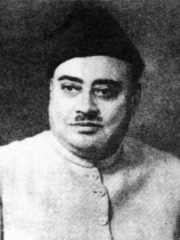
10. Khawaja Nazimuddin (1894 - 1964)
With an HPI of 60.69, Khawaja Nazimuddin is the 10th most famous Bangladeshi Politician. His biography has been translated into 37 different languages.
Sir Khawaja Nazimuddin (19 July 1894 – 22 October 1964) was a Pakistani politician and statesman who served as the second governor-general of Pakistan from 1948 to 1951, and then as the second prime minister of Pakistan from 1951 to 1953. Born into an aristocratic Nawab family in Bengal, he was educated at Aligarh Muslim University before pursuing post-graduation studies at the Cambridge University. Upon returning, he embarked on his journey as a politician on the platform of the All-India Muslim League. His political career initially revolved around advocating for educational reforms in Bengal, later focusing on supporting the Pakistan Movement, a campaign for a separate Muslim homeland. Nazimuddin rose to popularity as the party's principal Bengali leader and a close associate of Muhammad Ali Jinnah. He served as Prime Minister of Bengal in British India from 1943 to 1945, and later as the 1st chief minister of East Bengal in independent Pakistan from 1947 to 1948. Nazimuddin ascended to governor-general in 1948 after the death of Jinnah, before becoming prime minister in 1951 following the assassination of his predecessor, Liaquat Ali Khan. His term was marked by constant power struggles with his own successor as governor-general, Ghulam Muhammad, as law and order deteriorated amid the rise of the Bengali language movement and protests in his native Dhaka in 1952, and religious riots in Lahore a year later. The latter crisis saw the first instance of martial law, limited to the city, and led to Governor-General Ghulam Muhammad dismissing Nazimuddin on 17 April 1953. Nazimuddin's ministry was the first federal government to be dismissed in Pakistan's history, though his former ministers, Sardar Abdur Rab Nishtar, Abdul Sattar Pirzada, and Mahmud Husain refused to take the oath of office in the new cabinet. He retired from national politics, dying after a brief illness in 1964. He is buried at the Mausoleum of Three Leaders in Dhaka. He was one of the leading founding fathers of Pakistan and the first Bengali to have governed Pakistan.
People
Pantheon has 26 people classified as Bangladeshi politicians born between 250 and 1983. Of these 26, 5 (19.23%) of them are still alive today. The most famous living Bangladeshi politicians include Sheikh Hasina, Mohammed Shahabuddin, and Abdul Hamid. The most famous deceased Bangladeshi politicians include Chandragupta I, Sheikh Mujibur Rahman, and Mohammad Ali Bogra.
Living Bangladeshi Politicians
Go to all RankingsSheikh Hasina
1947 - Present
HPI: 79.96
Mohammed Shahabuddin
1949 - Present
HPI: 73.84
Abdul Hamid
1944 - Present
HPI: 70.13
Shirin Sharmin Chaudhury
1966 - Present
HPI: 46.20
Mashrafe Mortaza
1983 - Present
HPI: 35.35
Deceased Bangladeshi Politicians
Go to all RankingsChandragupta I
250 - 335
HPI: 75.07
Sheikh Mujibur Rahman
1920 - 1975
HPI: 69.56
Mohammad Ali Bogra
1909 - 1963
HPI: 65.87
Zillur Rahman
1929 - 2013
HPI: 64.44
Ziaur Rahman
1936 - 1981
HPI: 63.30
Iajuddin Ahmed
1931 - 2012
HPI: 61.87
Khawaja Nazimuddin
1894 - 1964
HPI: 60.69
Shahabuddin Ahmed
1930 - 2022
HPI: 59.29
A. B. Bardhan
1924 - 2016
HPI: 58.56
Tajuddin Ahmad
1925 - 1975
HPI: 57.93
Abdur Rahman Biswas
1926 - 2017
HPI: 56.95
Khondaker Mostaq Ahmad
1918 - 1996
HPI: 56.49
Overlapping Lives
Which Politicians were alive at the same time? This visualization shows the lifespans of the 20 most globally memorable Politicians since 1700.

